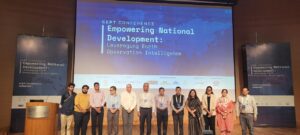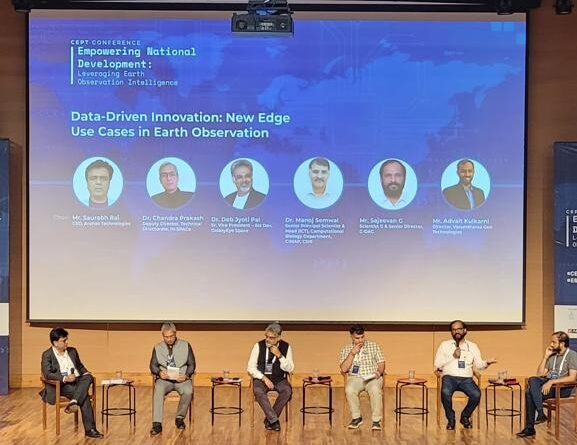CEPT University Symposium highlights Earth Observation Intelligence as Key to India’s National Development
Hitesh Kumar, Dep Director General, Survey of India advocates Partnerships and CORS Networks to Enhance Geospatial Technologies in India
BILKULONLINE
Ahmedabad, Oct 14: The Center for Applied Geomatics (CAG) at CEPT University, in collaboration with the Survey of India (SOI) and National Remote Sensing Centre (NRSC), inaugurated a two-day symposium titled ‘Empowering National Development: Leveraging Earth Observation Intelligence’ today at the CEPT University campus.
The event focuses on the transformative role of Earth Observation (EO) technologies in advancing India’s national development goals, while promoting data-driven decision-making across sectors.
Hitesh Kumar, Deputy Director General, Survey of India (SOI), stressed the importance of partnerships and infrastructure in maximizing the potential of geospatial technologies. He said, “For geospatial technologies to truly deliver value, partnerships between government, academia, and industry are crucial. The Survey of India is committed to creating synergies with stakeholders to ensure the successful adoption and use of EO technologies in national projects. With the development of CORS (Continuously Operating Reference Stations) networks across the country, we are building a robust foundation for high-precision positioning services. This infrastructure, alongside initiatives like the Digital India Land Records Modernization Programme (DILRMP), will provide critical support for a wide range of public services, from disaster management to infrastructure development.”

The Center for Applied Geomatics (CAG) at CEPT University, in collaboration with the Survey of India (SOI) and National Remote Sensing Centre (NRSC), inaugurated a two-day symposium titled ‘Empowering National Development: Leveraging Earth Observation Intelligence’ today at the CEPT University campus. The event focuses on the transformative role of Earth Observation (EO) technologies in advancing India’s national development goals, while promoting data-driven decision-making across sectors.

The symposium aims to raise awareness about the vast potential applications of EO and serves as a platform for stakeholders to share insights, deliberate on solutions, and discuss policy frameworks, regulations, and governance structures. The event also facilitates knowledge exchange, best practices in EO data acquisition, processing, analysis, and utilization. With space-based imagery playing an increasing role in commercial applications and public services globally, EO intelligence has become essential, particularly in fields like agriculture, urban planning, disaster management, and climate change. This makes it a valuable tool for government agencies, industry professionals, and academic researchers.
Dr. Prakash Chouhan, Director of the National Remote Sensing Centre (NRSC), underscored the importance of EO data in socioeconomic development. “The Department of Space has made satellite data with a resolution above 5 meters freely available to the public under the National Space Policy 2023. This includes various datasets like LISS 4, LISS 3, and Oceansat at Bhoonidhi. Exciting applications are emerging, especially in digital agriculture and land records, and the next decade promises to harness EO’s potential for climate and disaster management,” he remarked.
Rajendra Ratnoo, Executive Director of the National Institute of Disaster Management (NIDM), highlighted the role of geospatial technology in disaster management. He noted, “Geospatial technology, combined with big data and machine learning, is transforming disaster management by enabling more precise planning, response, and risk assessment. Credible EO data provides critical insights for last-mile connectivity, urban flooding, and disaster response. We are eager to collaborate in creating knowledge verticals that bridge policy, research, and action on disaster management and climate adaptation.”
Nilesh Desai, Director of the Space Applications Centre (SAC) at ISRO, acknowledged the significance of EO technologies in national development, particularly in the context of the Chandrayaan-3 mission. He said, “On National Space Day, celebrated on October 14th, we recognize the advancements in EO for national development. The integration of AI and machine learning is transforming EO and space technology, enhancing product generation and analysis. As we innovate—from different sensors to improved resolution—we must be mindful of how we train AI. This year’s Nobel Prize recognizes major contributions in AI, comparable to the legacy of Oppenheimer. At SAC, ISRO, we are advancing technologies like LiDAR, hyperspectral imaging, and radar, moving from analysis-ready to AI-ready data.”
The event features panel discussions and one-on-one Q&A sessions with policymakers, providing participants with insights into the latest EO tools and technologies, and real-world applications in areas like disaster response, land use management, and environmental sustainability.
Professor Barjor Mehta, President of CEPT University, emphasized the symposium’s relevance, stating, “This symposium will serve as a valuable platform as we bring together stakeholders from across the spectrum to discuss the potential of space-based imagery. By fostering collaboration and exploring innovative applications, we can unlock new opportunities and create a better future.”
Suren Vakil, Vice-Chairperson of CRDF, added, “As India continues to make strides in technological innovation, the role of Earth Observation intelligence cannot be overstated. This event highlights EO technologies that are key to national development and bring tangible benefits to communities across India.”
Dr. Shivangi Somvanshi, Center Head of the Center for Applied Geomatics (CAG), concluded, “Our mission at the Center for Applied Geomatics (CAG) is to use geospatial data to solve real-world problems. With this symposium, we aim to demonstrate the real-world impact of EO intelligence in solving complex challenges at national and community levels.”



